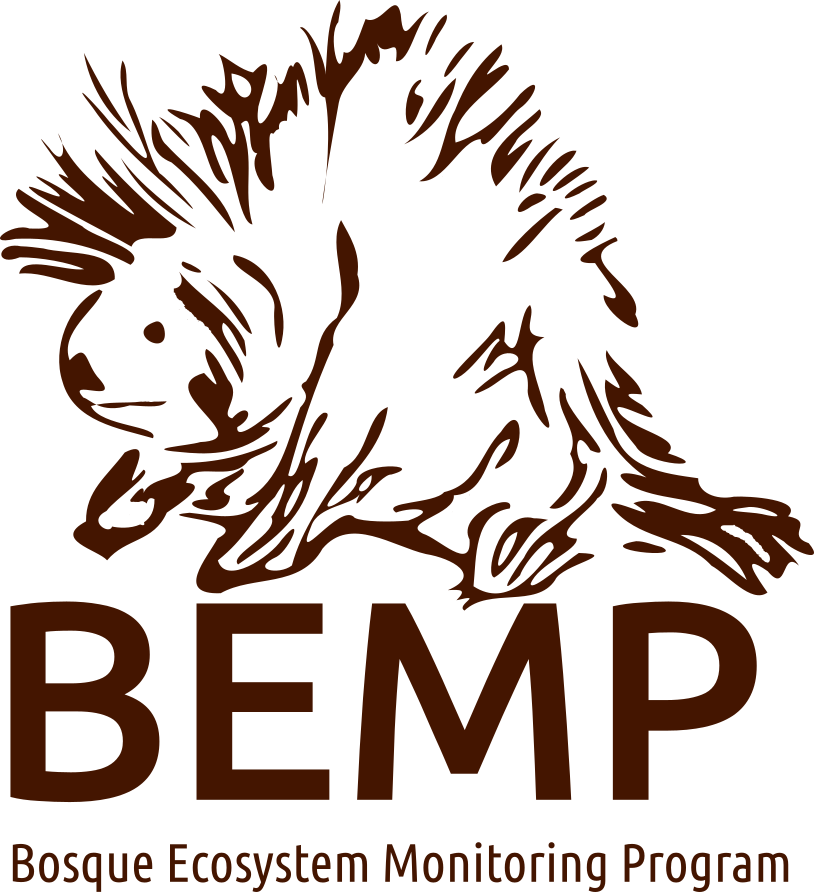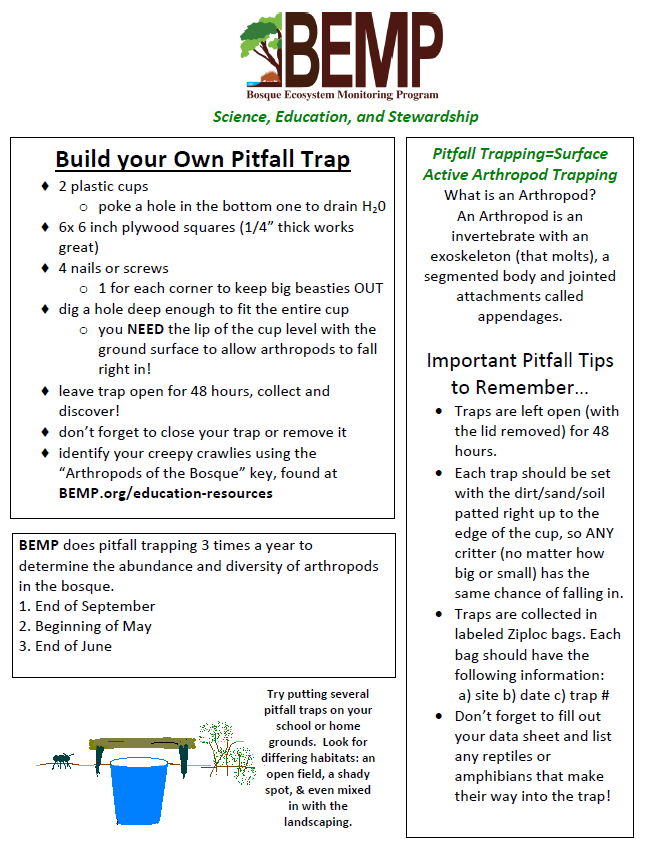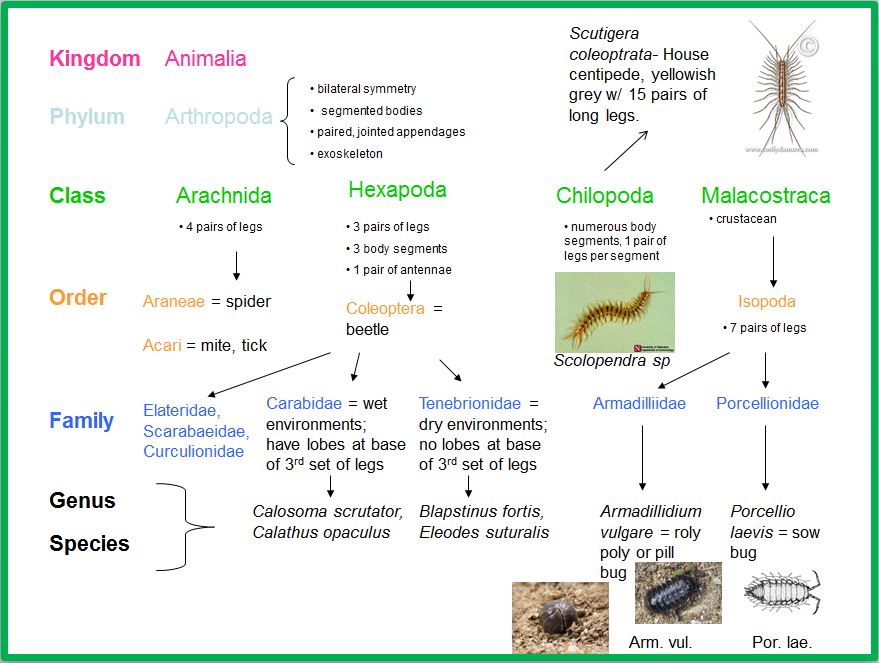Monthly Monitoring Education
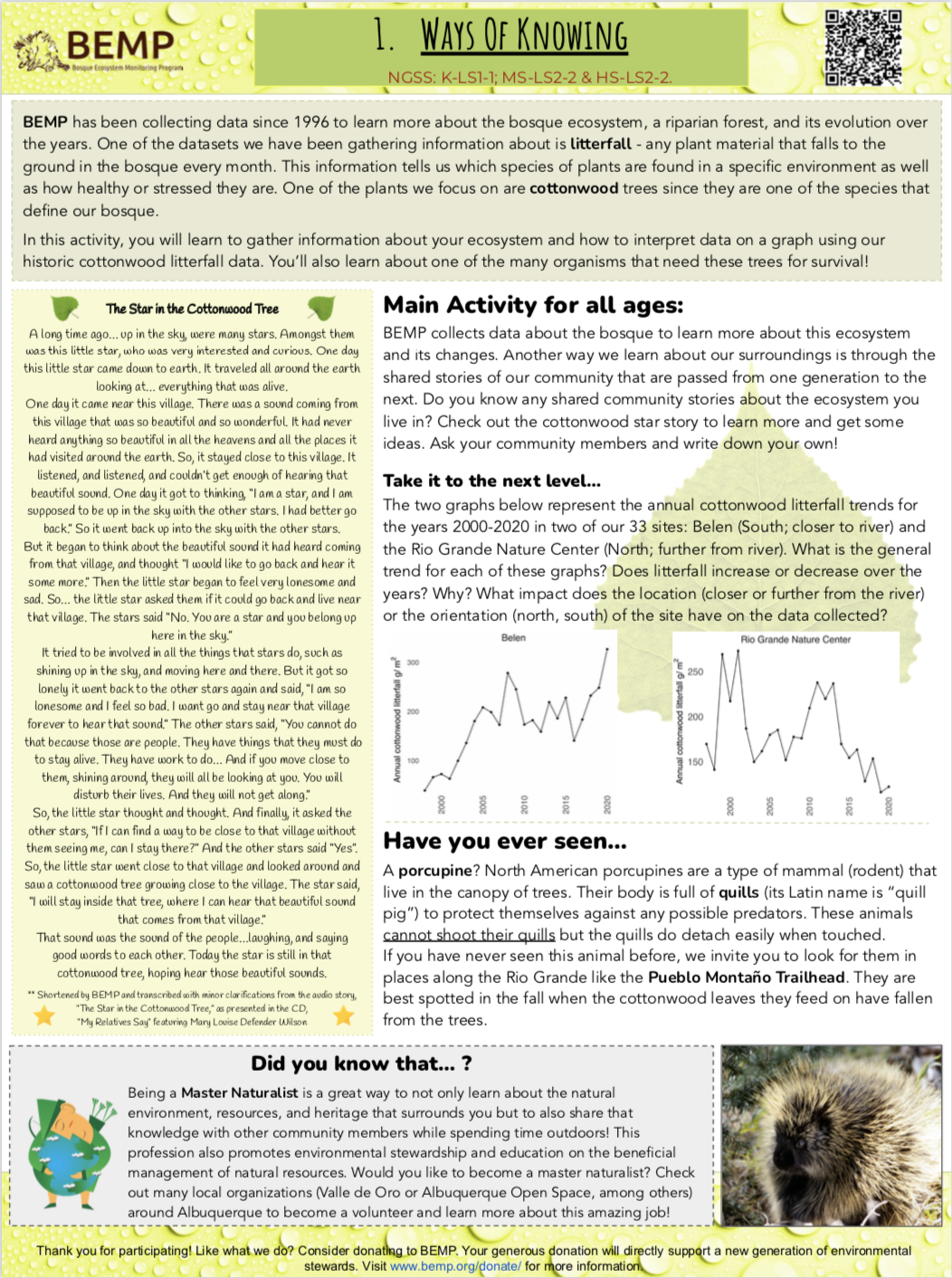
Ways of Knowing (for all ages!)
In this activity, you will learn to gather information about your ecosystem and how to interpret data on a graph using our historic cottonwood litterfall data. You’ll also learn about one of the many organisms that need these trees for survival!
Tipos de Conocimiento (¡para todas las edades!)
En esta actividad, aprenderás a recopilar información sobre tu ecosistema y cómo interpretar los datos en un gráfico utilizando nuestros datos históricos de hojarasca de los álamos. ¡También aprenderás sobre uno de los muchos organismos que necesitan estos árboles para sobrevivir!
NGSS: K-LS1-1; MS-LS2-2 & HS-LS2-2

Arthropods & Habitat (for all ages!)
By doing this activity, you will learn about the changes arthropods undergo throughout their life cycle and the adaptations they develop to live in specific environments. You will also learn how different families of arthropods can give you information about the habitat they live in through real BEMP-collected data!
Artrópodos y Hábitat (¡para todas las edades!)
Al realizar esta actividad, aprenderás sobre los cambios que experimentan los artrópodos a lo largo de su ciclo vital y las adaptaciones que desarrollan para vivir en entornos específicos. ¡También aprenderás cómo las diferentes familias de artrópodos pueden darte información sobre el hábitat en el que viven a través de datos reales recopilados por BEMP!
NGSS: K-ESS3-1; MS-LS2-1 & MS-LS2-4
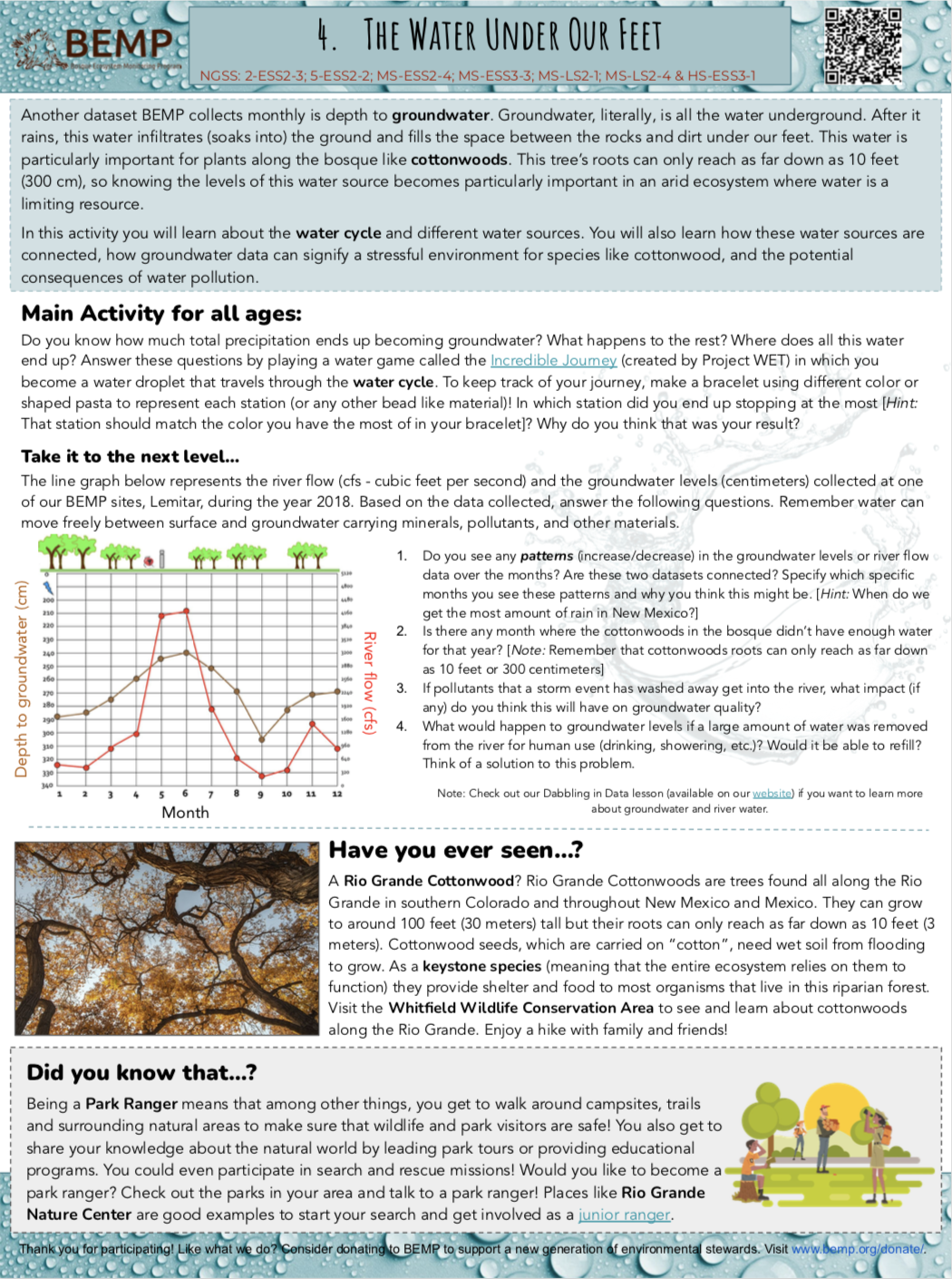
The Water Under Our Feet (for all ages!)
In this activity you will learn about the water cycle and different water sources. You will also learn how these water sources are connected, how groundwater data can signify a stressful environment for species like cottonwood, and the potential consequences of water pollution.
El Agua Bajo Nuestros Pies (¡para todas las edades!)
En esta actividad aprenderás sobre el ciclo del agua y las diferentes fuentes de agua. También aprenderás cómo se conectan estas fuentes de agua, cómo los datos de aguas subterráneas pueden significar un ambiente estresante para especies como el álamo y las posibles consecuencias de la contaminación del agua.
NGSS: 2-ESS2-3; 5-ESS2-2; MS-ESS2-4; MS-ESS3-3; MS-LS2-1; MS-LS2-4 & HS-ESS3-1
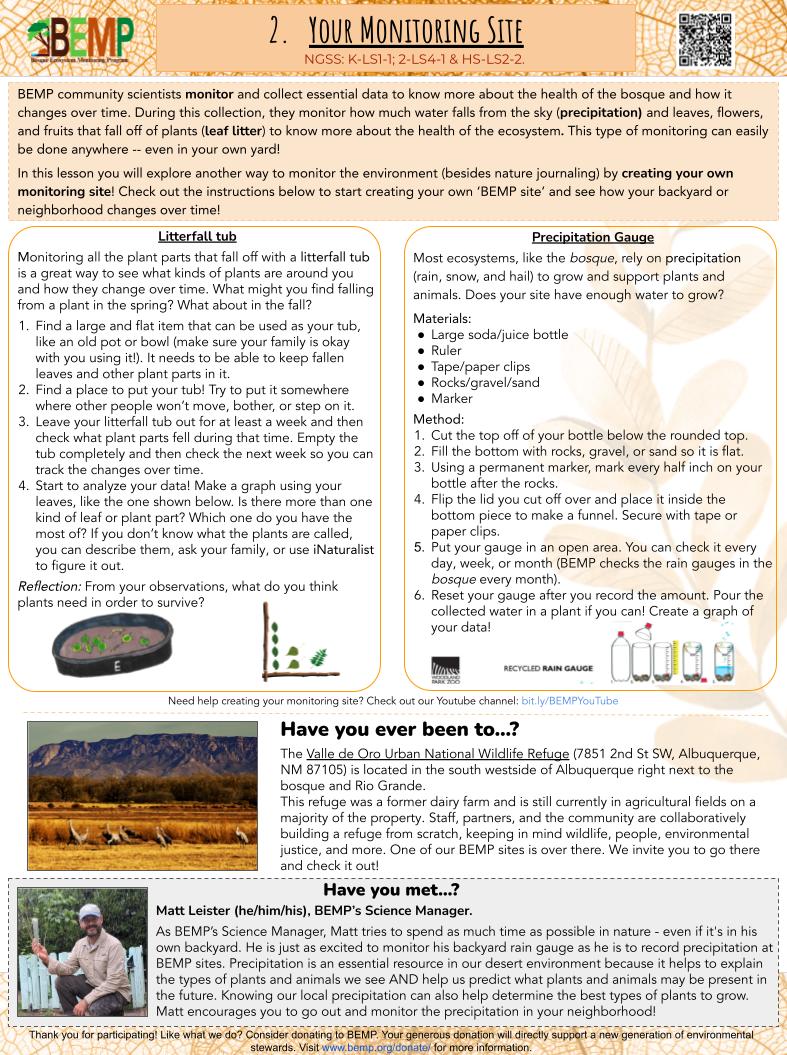
Your Monitoring Site (for all ages!)
In this lesson you will explore another way to monitor the environment (besides nature journaling) by creating your own monitoring site!
Tu Sitio de Monitoreo (¡para todas las edades!)
En esta lección explorarás otra forma de monitorear el medio ambiente (aparte de llevar un diario de la naturaleza) ¡creando tu propio sitio de monitoreo!
NGSS: K-LS1-1; 2-LS4-1 & HS-LS2-2
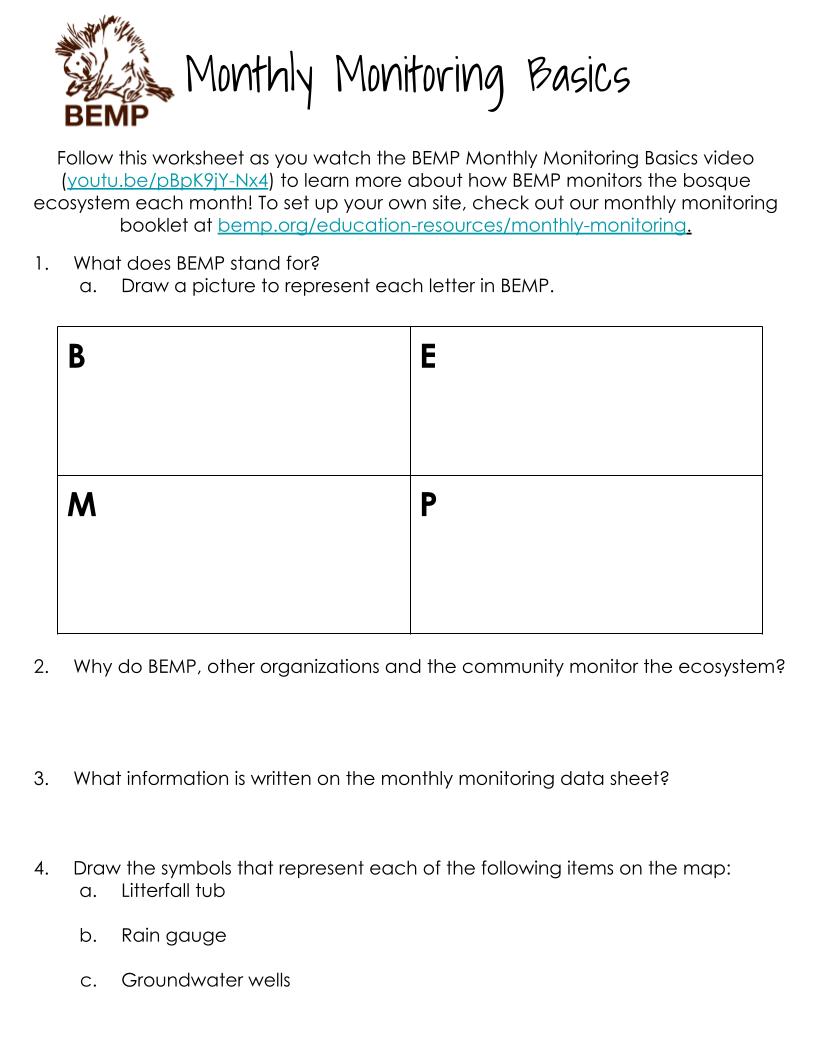
BEMP Monthly Monitoring Basics (for all ages!)
Follow this worksheet as you watch the BEMP Monthly Monitoring Basics video to learn more about how BEMP monitors the bosque ecosystem each month!
Bases del Monitoreo Mensual de BEMP (¡para todas las edades!)
Sigue esta hoja de trabajo a la vez que ves el vídeo de los Básicos del Monitoreo Mensual de BEMP para aprender más sobre cómo BEMP monitorea el ecosistema del bosque cada mes!
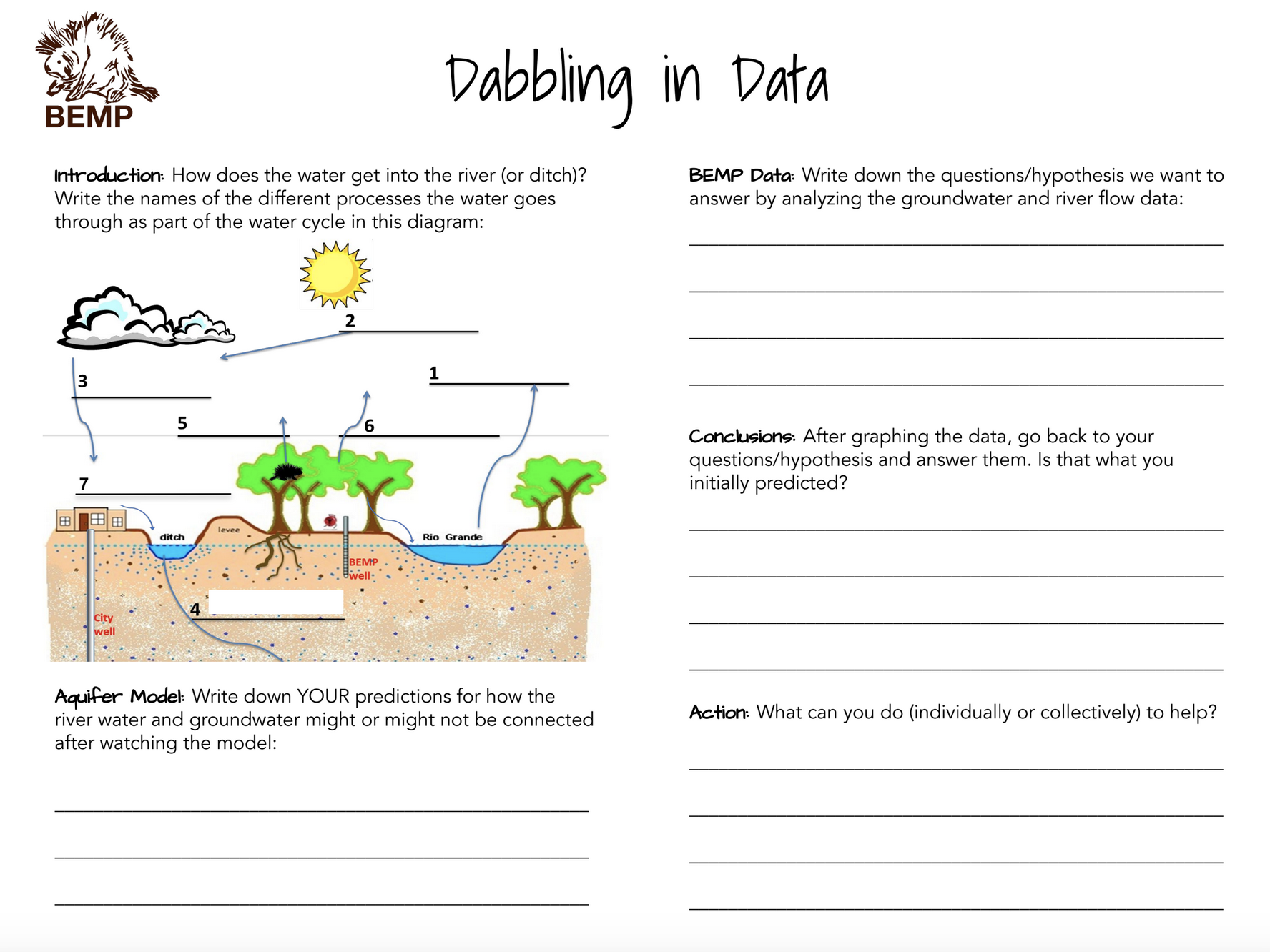
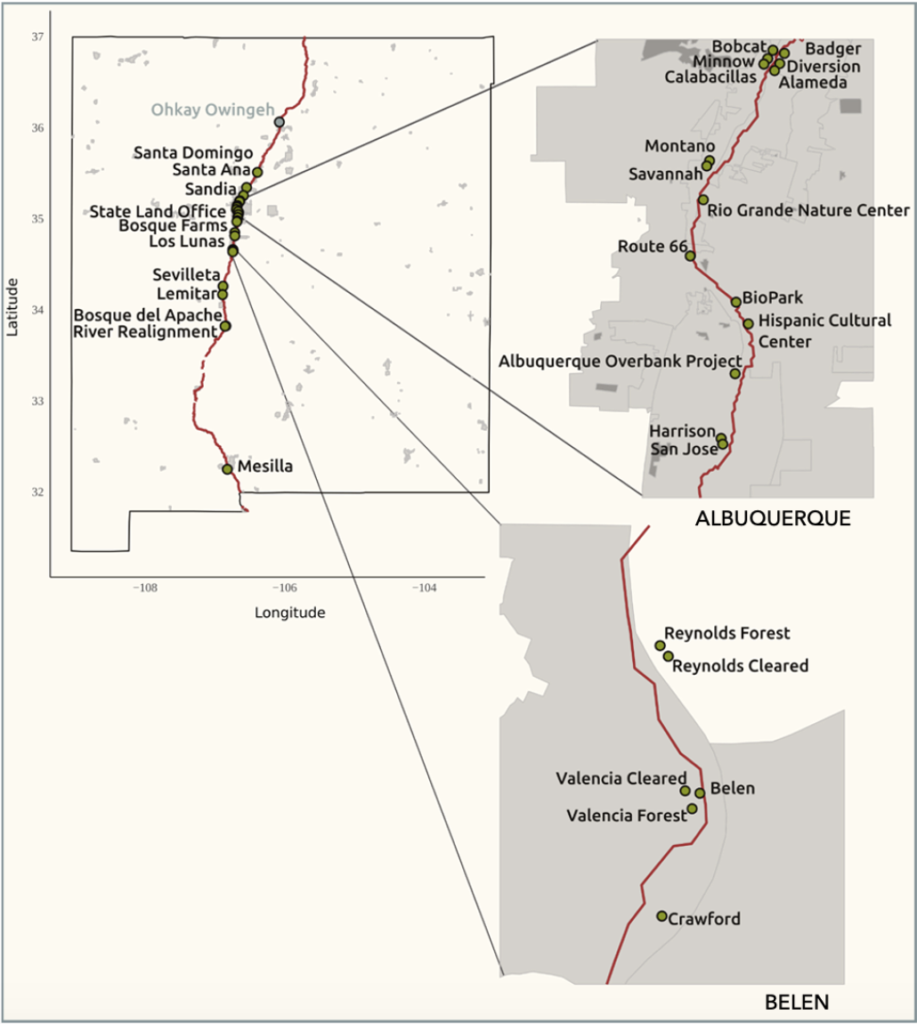
Dabbling in Data (MS & HS)
During this lesson, students will learn about BEMP’s groundwater dataset: what it is, how we measure it, and why it’s important. They will also understand how water arrives there by considering how the water cycle moves through the Rio Grande Valley using an aquifer model.
Afterwards, students will learn how to graph groundwater and streamflow data for different BEMP sites. Students will look at several years of data to discuss the relationship between river and groundwater and how pollution might impact that connection.
At the end, students will propose several actions they can adopt to encourage community stewardship of the bosque ecosystem.
NGSS: MS-ESS2-4; MS-ESS3-3 & HS-ESS2-2 & HS-ESS3-6.
Inmersión en los Datos (MS & HS)
Durante esta lección, los estudiantes aprenderán sobre los datos de BEMP relacionados con el agua subterránea: qué es, cómo se mide y por qué es importante. También entenderán cómo el agua llega allí en primer lugar al considerar cómo se mueve dentro su ciclo en el Valle del Río Grande usando el modelo de un acuífero como ejemplo.
Posteriormente, aprenderán cómo representar los datos del agua subterránea y el flujo del río en forma de gráfica para los diferentes sitios de BEMP. Los estudiantes representarán varios años de datos para discutir la relación entre el río y el agua subterránea y cómo la contaminación podría afectar esa conexión.
Al final, propondrán varias acciones que pueden adoptar para fomentar la conservación del ecosistema del bosque de forma comunitaria y/o individual.
NGSS: MS-ESS2-4; MS-ESS3-3 & HS-ESS2-2 & HS-ESS3-6.
BEMP SITE TABLES:
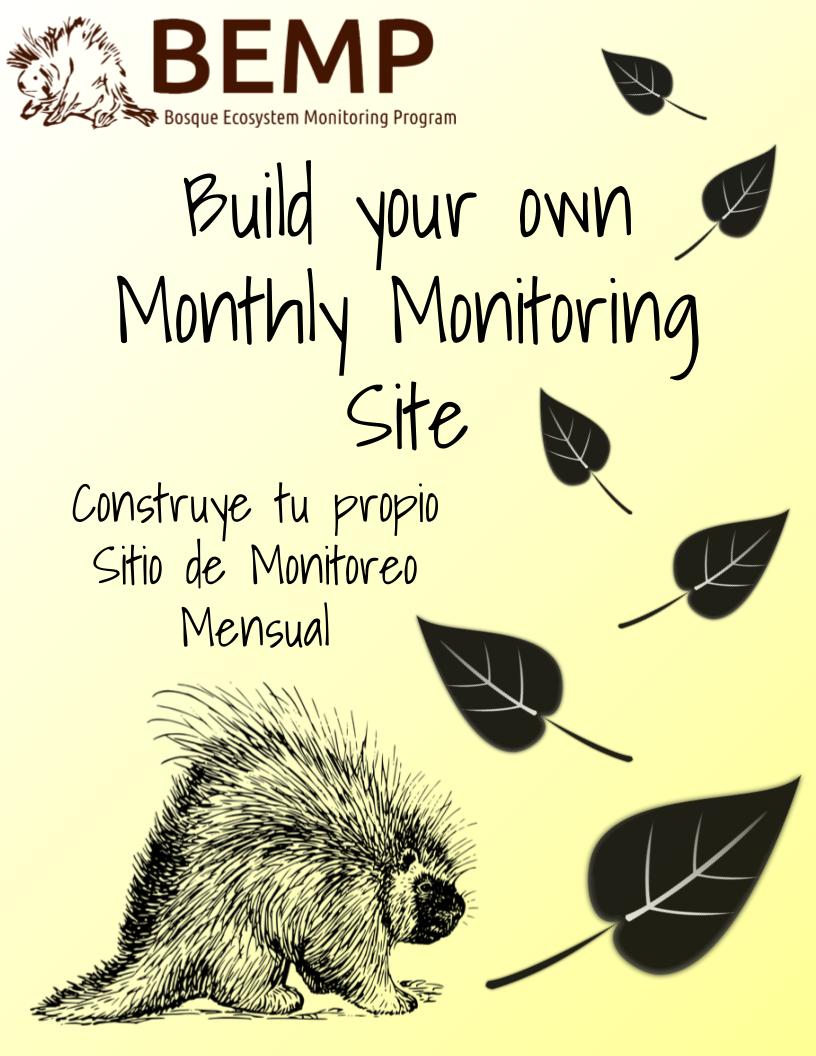
Build your own Monthly Monitoring site! (for all ages!)
Hello and welcome! With this booklet, we encourage you to set up your own monitoring site similar to how BEMP does in the bosque. Included, you will find:
- Four monthly monitoring datasets (plant litterfall, groundwater, precipitation, and surface arthropod pitfall trapping)
- Instructions for how to set up your own monitoring site
¡Construye tu propio Sitio de Monitoreo Mensual! (¡para todas las edades!)
¡Hola y bienvenide! Con este folleto, te animamos a que instales tu propio sitio de monitoreo similar a como lo hace BEMP en el bosque. Incluidos, encontrarás:
- Cuatro conjuntos de datos mensuales de seguimiento (hojarasca de plantas, aguas subterráneas, precipitaciones y trampas de artrópodos en la tierra).
- Instrucciones sobre cómo establecer tu propio sitio de monitoreo
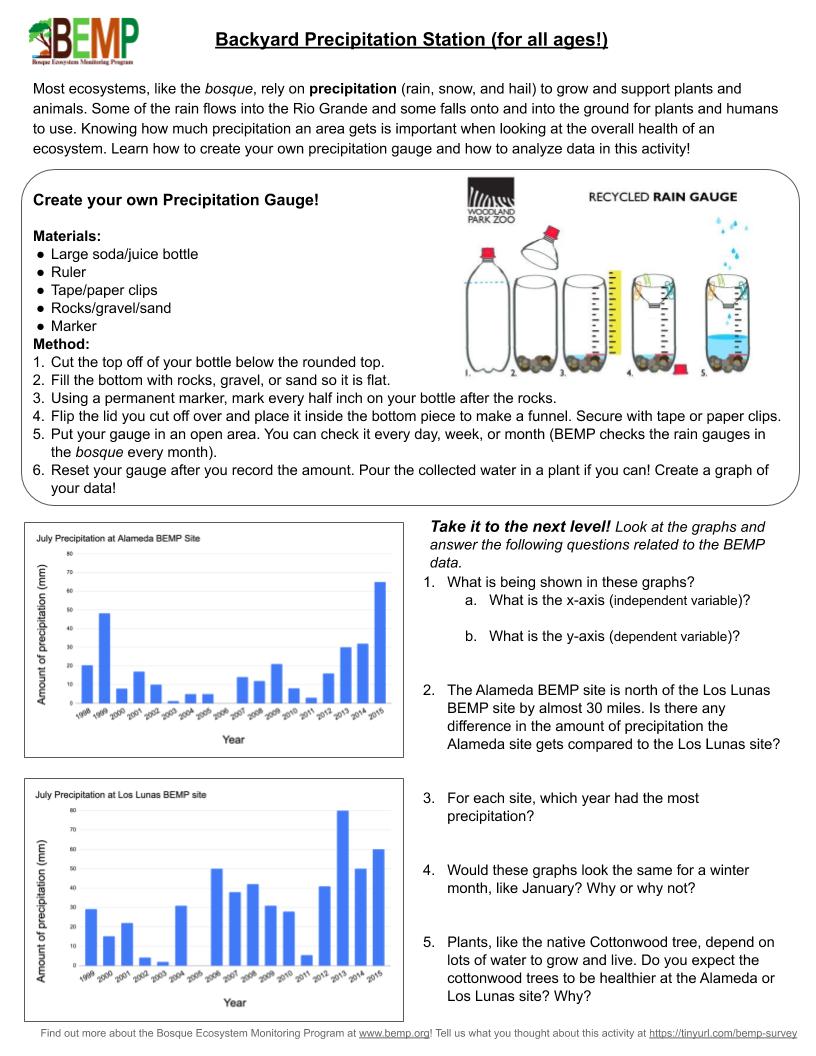
Backyard Precipitation Station (for all ages!)
Knowing how much precipitation an area gets is important when looking at the overall health of an ecosystem. Learn how to create your own precipitation gauge and how to analyze data in this activity!
Estación de precipitación en el jardín (¡para todas las edades!)
Saber cuánta precipitación recibe un área es importante cuando se observa la salud general de un ecosistema. ¡Aprende cómo crear tu propio medidor de precipitación y cómo analizar datos en esta actividad!
NGSS: 3-ESS2-1 & 3-LS4-4.

BEMP Arthropod Trapping (for all ages)
BEMP traps arthropods, like roly polys and ants, in the bosque three times a year to learn about the health of the ecosystem. This activity will show you how to create your own arthropod trap to see what is in your yard or neighborhood!
BEMP Trampas para Artrópodos (¡para todas las edades!)
BEMP atrapa en el bosque tres veces al año artrópodos, como cochinillas y hormigas para aprender acerca de la salud del ecosistema. ¡Ésta actividad te mostrará cómo crear tu propia trampa para artrópodos y ver que hay en tu patio trasero o vecindario!
NGSS: 2-LS4-1; MS-ESS3-3 & HS-ESS3-1.
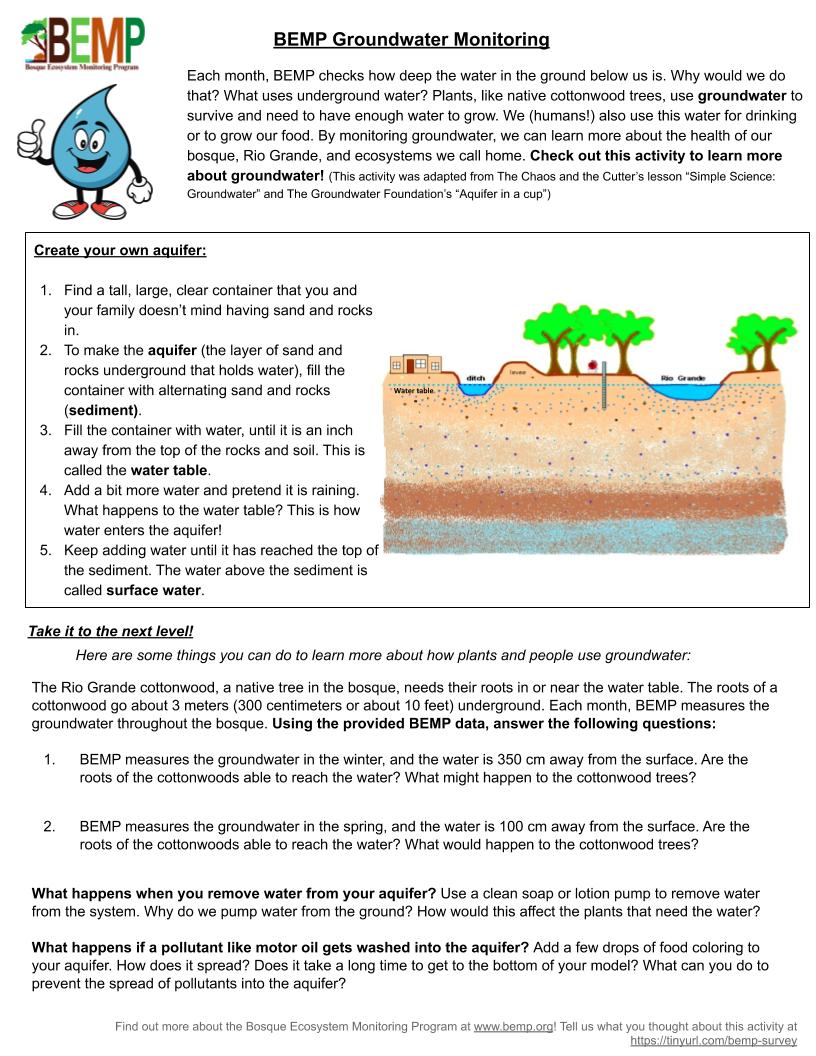
BEMP Groundwater Monitoring (for all ages)
Each month, BEMP checks how deep the water in the ground below us is. Why would we do that? What uses underground water? Check out this activity to learn more about groundwater!
BEMP Monitoreo del agua subterránea (¡para todas las edades!)
Cada mes, BEMP comprueba la profundidad del agua debajo de nosotros. ¿Por qué haríamos eso? ¿Qué usa el agua subterránea? ¡Mira ésta actividad para aprender más sobre el agua subterránea!
NGSS: K-LS1-1; 2-ESS2-2; 2-ESS2-3; MS-ESS3-3 & HS-ESS3-1.

BEMP Backyard Monitoring (for all ages)
Each month, BEMP community scientists collect essential data about the health of the bosque and how it changes over time. To start creating your own ‘BEMP site’ and see how your backyard or neighborhood changes over time, check out the instructions below!
BEMP Monitoreo del patio trasero (¡para todas las edades!)
Cada mes, los científicos de la comunidad de BEMP recopilan datos esenciales acerca de la salud del bosque cómo cambia con el tiempo. Para comenzar a crear su propio “sitio BEMP” y ver cómo su patio trasero o vecindario cambia con el tiempo ¡consulte las instrucciones a continuación!
NGSS: K-LS1-1; 2-LS2-1; 2-LS4-1 & 3-ESS2-1.

Bosque Plants (for all ages!)
In this activity, you will learn techniques for sorting leaves you collected in your monitoring station. Then, once you’ve sorted your data, you’ll learn how to identify those leaves using iNaturalist and then make your own piece of artwork!
Plantas del Bosque (¡para todas las edades!)
En esta actividad, aprenderás técnicas para clasificar las hojas que hayas recogido en tu estación de monitoreo. Luego, una vez que hayas clasificado tus datos, aprenderás a identificar esas hojas usando iNaturalist y ¡después harás tu propia obra de arte!
PITFALL TRAPPING & ARTHROPOD IDENTIFCATION
A detailed list of instructions to create pitfall traps at your own school. Helpful keys and images for identification of arthropods in the bosque and beyond.
